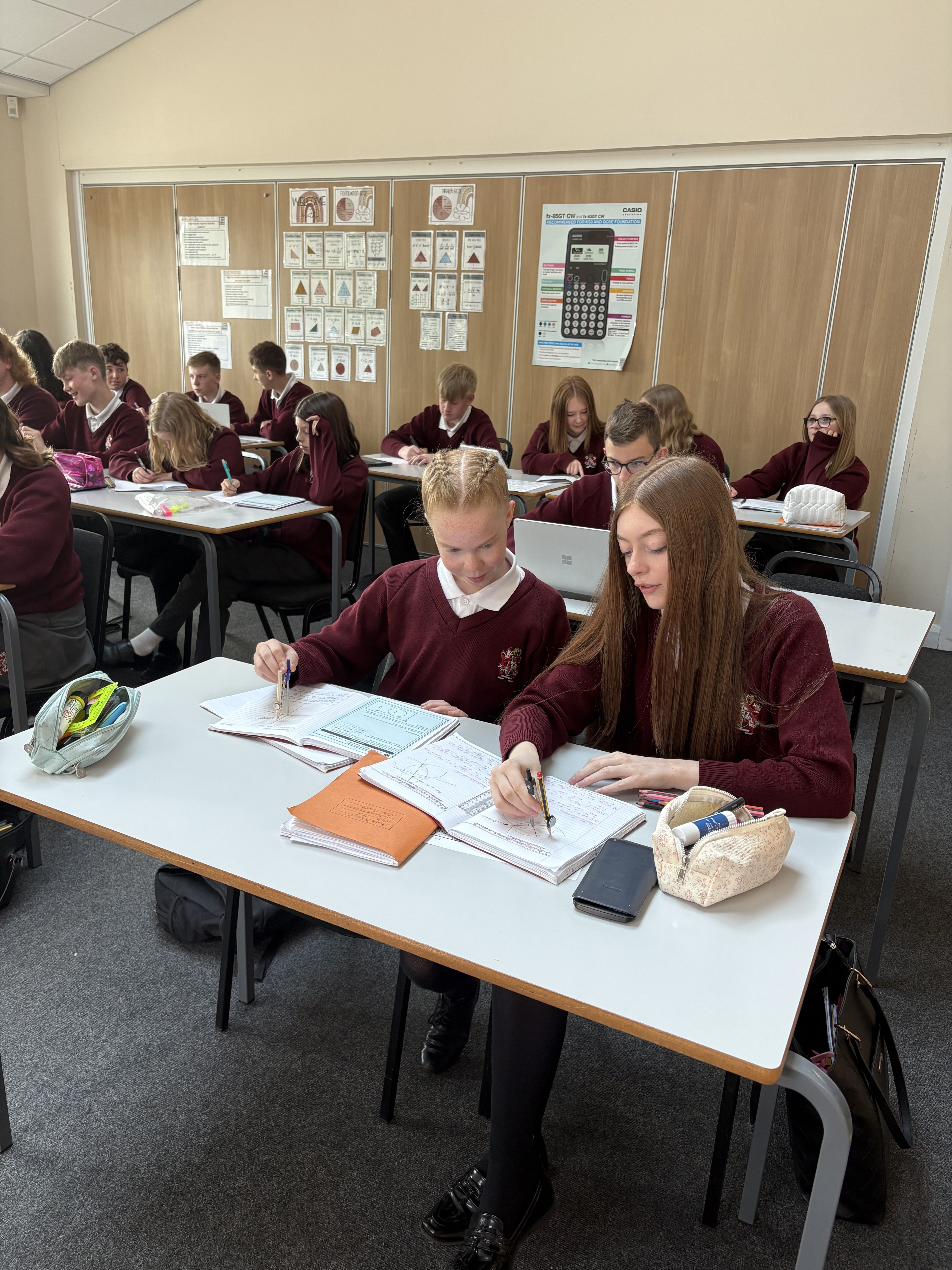Mathematics

Overview
Mathematics at Saint Aidan’s Church of England High School is a core subject delivered with high expectations and a strong emphasis on both mastery and enjoyment. The department follows a carefully sequenced spiral curriculum that builds deep understanding from Year 7 through to GCSE, with a clear focus on fluency, reasoning, and problem-solving. At Saint Aidan’s, maths is not just about passing exams—it’s about developing confident, independent thinkers equipped with the skills to succeed in a wide range of future pathways.
Key Stage 3
At Key Stage 3, students are grouped based on their ability, ensuring that each student is appropriately challenged and supported in working towards the highest possible standard by the end of each academic year.
All students receive three mathematics lessons per week, taught by experienced specialist teachers. Lessons incorporate a variety of teaching methods to cater to different learning styles. Technology such as tablets and interactive whiteboards is often used, alongside collaborative activities like paired work, card sorts, and Kagan structures. Traditional individual learning methods, including textbook and worksheet-based tasks, are also included to ensure students become secure in the mathematics they are taught. Homework is set once each week for all students to reinforce classroom learning.
The curriculum is designed around a shared Scheme of Learning that fully meets the National Curriculum requirements. It spirals from one year to the next, with carefully sequenced content to minimise unnecessary repetition while reinforcing foundational knowledge. The curriculum is intended to stretch students across all ability levels, helping them develop fluency and precision through a balance of declarative and procedural knowledge. Contextual problem-solving is embedded to enrich students’ mathematical understanding. Students with special educational needs and disabilities follow the same curriculum, supported by teaching assistants where appropriate to ensure accessibility and inclusion.
Progress is closely monitored through a combination of regular in-class assessments and a formal end-of-year examination. At the end of each year, students sit one written exam that covers the content taught which evaluates overall mathematical skills. These assessments are structured to reflect the demands of GCSE-style questions. Where students are not meeting their expected progress, targeted intervention strategies are implemented to provide the support needed to help them succeed.
Key Stage 4
Each GCSE Mathematics class at Saint Aidan’s is taught by two mathematics teachers, with each teacher delivering content from three of the six core strands:
· Number
· Algebra
· Ratio, Proportion and Rates of Change
· Geometry and Measures
· Probability
· Statistics
We believe this shared approach provides comprehensive curriculum coverage and allows for effective collaboration in addressing student needs.
Students are placed into sets based on ability, with some groups following the Higher tier Scheme of Learning, and others following the Foundation tier. Typically, students targeting grades 6 to 9 are entered for the Higher Tier, while those aiming for grades 4 to 5 are entered for the Foundation Tier.
To ensure students are on the most appropriate pathway, all GCSE students sit internal exams twice yearly—in December and March of both Year 10 and Year 11. These assessments play a key role in evaluating progress and determining the most suitable exam tier.
Our Schemes of Learning are carefully sequenced and include regular opportunities for interleaving, allowing students to revisit and strengthen key concepts across the six strands. Student progress is closely monitored using five mock exams throughout the course, with decisions about tier entry adjusted as needed to best support student success.

Homework
At Saint Aidan’s, we use Sparx Maths to support our homework provision in Mathematics. Homework is set weekly by the class teacher during term time only, and is carefully aligned with classroom learning.
Sparx provides personalised practice that helps consolidate key skills and deepen understanding. Teachers use the results from homework to identify misconceptions and inform future lesson planning. This ensures that support and challenge are appropriately targeted for every student.
Students are expected to show all their working out in their maths exercise books, reinforcing good habits in mathematical reasoning and written communication. Regular review of homework in lessons helps to embed learning and address areas for improvement promptly.
Enrichment
At Saint Aidan’s, we are committed to developing students into confident, investigative problem solvers. Throughout their time at the school, students are encouraged to think critically, explore patterns, and approach problems with creativity and resilience.
Many of our high-achieving students take part in the UK Mathematics Trust (UKMT) Maths Challenges, with a strong track record of success. Pupils regularly gain recognition through certificates at both the Junior level (Years 7 and 8) and the Intermediate level (Years 9, 10 and 11), celebrating their achievements in these nationally recognised competitions.
In addition to national challenges, we actively seek out mathematics competitions across the North-West. These regional opportunities allow our students to further test their skills, collaborate with peers from other schools, and experience the excitement of competitive problem solving in a variety of formats.
Department Staff
| Mrs A Jenkinson | Director of Mathematics |
| Miss M Moore | Key Stage 3 Coordinator for Mathematics |
| Mr S Calvert | Mathematics Teacher, Assistant Headteacher |
| Miss A Dixon | Mathematics Teacher, Head of Year |
| Mr E Morgan | Mathematics Teacher |
| Mr M Yates | Mathematics Teacher |
| Miss J Finnegan | Mathematics Teacher |
